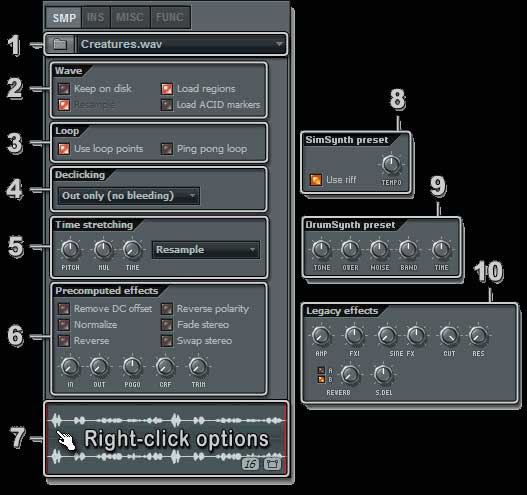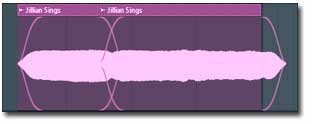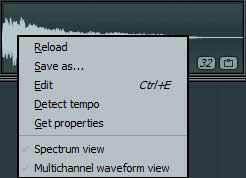How does work FL Studio Sampler
How does work FL Studio Sampler
Internal VST instruments and effects of FL Studio

Hello dear colleagues. Today we talk about internal vst instruments of FL Studio. Fl studio Sampler is a built-in tool Fl studio. Of course Fl studio Sampler is not a plug-in. Used to create the samples.
Note: You may notice that some of the options in your window Sampler disabled (gray), but you can toggle switches incl. / Off. This feature improves workflow when you try different samples in a sampler, and if the parameter will be able to turn on, it is automatically activated.
Content:
- Folder of sample
- Wave
- Loop
- Declicking
- Time stretching/Pitch shifting
- Precomputed effects
- Overview window sample
- SimSynth presets
- DrumSynth presets
- Legacy Precomputed Effects
Folder of sample
Press Left button of mouse on the left side to view a sample or SimSynth / DrumSynth blank sample bank. Open dialogue, has been extended with the Favorites section. Combo box in the right pane displays the name of the selected sample. If you click left button of mouse, a list of stories from the recently opened samples show.
Sample bank contains sounds that uses a sampler to play. One sample that is selected in the list (example - Creatures.wav), is bootable in the sampler. Left off the list is a button (the folder icon), opens a standard dialog box to load the sound file into the sampler. In the process of selecting the file name, and the waveform is displayed in the information field in the main panel. FL Studio supports audio files up to 96 000 Hz / 24 bit. That is, the sampling rate / bit, respectively.
Wave
Contains audio processing options: Keep on Disk (save to disk) - sampler can play audio files in two ways - directly from the hard disk or RAM. The first method of sample playback option corresponds Keep on disk. The advantage of this mode - saving RAM drawback - the inability to use the sample processing group Precomputed effects (more on that shortly). Keep on disk option is available only if the audio file format is 16/32 bit format and is not support OGG or Mp3.
Resample (resampling) - if the sample is not recorded in stereo 44100 kHz, 16-bit, you can use the Resample for better sound quality. Nevertheless, it is not recommended to use this option for samples having information about the loop, as this may cause clicks.
Although this option improves the playback in real time, it also uses additional CPU and memory resources.Load regions (loading areas) - sound files may contain information on the breakdown of the sample (slices) into separate fragments (for a more precise fit the tempo song (file format ZGR / REX).
If this option (Load regions) is enabled, FL Studio will use this information. Such a division of the sample for more accurate processing of the sample when it is stretched in time.
Load ACID markers (markers loading ACID) - selecting this option loaded ACID-markers, if any. ACID-markers - is approximately the same as the slices.
Loop
Contains options looping samples: Use Loop Points - if the sample contains a point of the cycle (see Sample view, below), you can use this option to work with loops.
Loop will be played first, and when it reaches the end point of the cycle, it will jump to the beginning of the cycle. Thus, a sound of unlimited length. Useful when using strings sounds, brass, etc...
Ping Pong Loop (mirror loop playback) - the option to change the above order. In this mode, when you come to the right edge loop sampler will be play the waveform in the opposite direction until until it reaches the left border. Upon reaching the left border will continue playing in the "right" direction (left to right). And so it will continue until pressed MIDI-key. In some rare cases, Ping pong Loop option allows you to make cycling more natural.
Declicking
This option is provided for the removal of "clicks" at the beginning or end of the sample caused by a click occurs when the sample is not starting from zero point (a sharp jump from silence to sound), it may be caused by not properly threaded samples. The default value is Out only (fade in 10 ms), it will not cause audible artifacts. Select the desired setting by ear.
From the drop-down menu you can select one of the ways to eliminate clicks:
 Out only (no bleeding) - not to carry out the removal of clicks, declicking-out 10 ms (cosine S-shaped) attenuation fades.
Out only (no bleeding) - not to carry out the removal of clicks, declicking-out 10 ms (cosine S-shaped) attenuation fades.- Transient (no bleeding) - useful for samples drum, fully preserves the attack (only processed the first few samples). Remove clicks stops after 10 ms, disappears filtering.
- Transient (bleeding) - exactly the same treatment as described above attack termination remove clicks in 20 ms (cosine S-shaped) attenuation fades.
- Generic (bleeding) - 20 ms cosine S-shaped appearance of smooth and gradual attenuation.
- Smooth (bleeding) - 100 ms cosine S-shaped appearance of smooth and gradual attenuation.
- Crossfade - 200 ms attack / recovery, which are intended for adjacent crossfade audio clips. This is not the case in contact krossfedov samples is when the sample is attenuated at the beginning and the end.
Time stretching/Pitch shifting
Using Time stretching / Pitch shifting (time stretching / Pitch Bend), you can synchronize the tone and / or sample rate of your project, because the tone and playback speed can be adjusted separately. Note that a more precise fit in time and height by using the tool Time Stretch / Pitch Shift plug-in Edison. However, this process is not possible in real time, and is only possible when using FL Studio on high-quality (multiprocessor) equipment to achieve professional results. When samples are synchronized to the tempo of the project, and you will change the tempo in the main program, it will offer to handle all samples in accordance with the new tempo. To disable the Time stretching for the sample, turn to the far left knob Time (0). This is the default when the samples are loaded into the Playlist.
Manual synchronization with the tempo of the project / Automatic synchronization of samples
- Pitch (pitch shift) - allows you to change the pitch of the sample, while maintaining its duration. Since this kind of treatment is not possible when choosing a method of stretching Resample, method will be automatically changed to «Auto» after rotating the knob.
- Mul (multiplier time) - Use this knob to adjust the length of the sample. For example, you can quickly stretch the sample twice without having to change the setting time.
- Time ( time stretch ) - This parameter determines the length of the sample , using basic measuring tempo (bars , steps , etc.) so that you can associate with a sample rate of the main project. When you rotate the knob to see the set time in the tips as well as FL Studio calculates the " actual " rate of the sample on the basis of fixed length . If the rate is too high or too low - you 'll see the note : «Unrealistic tempo«, displayed in place of these values. Menu when you right -click on this option displays a few manual settings and automatically determined parameters , which are trying to determine the tempo of the sample (results will vary depending on your source) . Note: Audio clips will be adjusted over time according to their extension.
- Right-click on the arm of Time - open menu with some useful presets and team avtooopredeleniya Autodetect, which tries to automatically determine the rate of the sample (results will vary depending on your source).
- - (none) - Default (without stretching), the sample is transferred into the channel in accordance with the pitch, as usual.
- - Autodetect - tempo (BPM) of the sample is automatically detected and stretched channel respectively. When working with recordings when tension in the playlist, this parameter will change automatically.
- - Beat / Bar # (shot / cycle) - use these options when you know the exact number of beats / bars sample.
- Stretching method (dropdown menu) - here chosen algorithm time stretching / pitch change for the sample. Keep in mind that the sampler channel implements algorithms simplified version «ZPlane Elastique Pro». We recommend the use of Edison, if you want maximum control over the processes of expansion over time / pitch change.
- - Resample - standard version, in which the length of the sample and changes the tone.
- - Pro default - mode "by default", is designed to work with a wide range of input signals. Use other methods only if this method is the "default" does not give you the desired result.
- - Pro transient - with some clicks sounds are crucial to the overall result (drums, for example). This mode tries to keep clicking in the input signal.
- - Transient - used for computers with low-power processor. Alternative regime Pro transient.
- - Tonal - provides higher quality input tonal character.
- - Monophonic - used for mono input signals (eg vocals or solo instruments) and should give the best results for this type of signals.
- - Speech - optimized for speech (for singing mode use Monophonic)
Working with function Time stretching / Pitch shifting
Dynamic tempo changes during playback of the project (the tempo automation) is not possible because of stretching algorithm does not work in real time. When you automate the global tempo of the project, from the samples will vary the pitch. To achieve dynamic stretching time use Fruity Granulizer.
Below are the general steps that you certainly require when working with stretching of samples:
- Disabling stretching for the sample, turn the handle for maximum Time left (0). This is the default mode when samples are added to the playlist.
- Manual override tensile sample when changing the tempo of the project. If your sample is not expanded automatically when you change the tempo of the project, then do the synchronization procedure with the sample project:
- Open the audio clip (in the upper left corner of the Audio Clip to play sheet) and select Fit to tempo (to adjust to the pace).
- In the window that appears, choose the tempo mark (project).
- Now the clip is synchronized (or locked) to the pace of the project. Further change of pace will automatically pull the clip so that it remains the original height. At any stage you can change the way you stretch to determine the best method. If you download an audio clip and it plays not fast enough, sm.Avtomaticheskoe sprain.
- Unblock sample from the pace of the project, do the above step 3 and select no tempo.
- Automatic tensile sample discharged into Playlist, FL Studio has to know the original tempo of the sample for the automatic extension of the sample. This information is contained in the meta-data of the sample, they are stored only in format WAV:
- Open Sample Properties (properties of the sample) in Edison.
- Make sure that the original tempo of the sample (Tempo (BPM)) is installed correctly, you may need to use Auto Detect function tempo.
- Turn Tempo-sync.
- Save the sample with these settings (only WAV-files can contain these meta-data).
- Make sure that the option Read sample tempo information included (F10).
Precomputed effects
This set of effects and sample processing programs loaded into the sampler. None of these effects does not require additional CPU resources when you play, because all these effects are applied to the sample to play. FL Studio processes the sample and then loads it into memory already applied effect. However, the use of streaming samples (when the option Keep on Disk), is the reason that a sample is loaded into memory, which is undesirable for longer samples.
- Remove DC Offset (DC offset removal) - permanent displacement may appear when the entire waveform is shifted relative to the axis of zero - very undesirable in a sound recording, because one of the causes of clicks. Permanent displacement occurs as a result of improper operation or sound recording tract due to low quality audio processing software.
- Reverse Polarity - «Flips" curve vertically (reverses the polarity of the signal).
- Normalize (normalization) - normalizes blood sample without clipping.
- Fade Stereo (stereo fades) - a smooth transition from the sound of the left channel to the right channel sound.
- Reverse (reversion) - turns the sample (plays in the opposite direction).
- Swap Stereo (exchange stereo) - varies between a right and left channels in the loaded sample.
- IN (fade In) - smooth increase the volume level (up to a maximum turn to the left to turn off).
- OUT (fade Out) - smooth decrease the volume level (up to a maximum turn to the left to turn off). Fade In and Fade Out is used to prevent clicks on the boundaries of the sample.
- POGO (pitch bend) - Control effect of changing the playback speed of the sample and, as a consequence, changes in pitch.
- CRF (crossfade Loop) - fundamentally solve the problem of clicks on the borders of the loop and a speaker can be looped sample using the Crossfade
- Loop (CRF is the corresponding control group Precompiled effects). The function works as follows: shortly before the end of the current cycle of the loop playback begins its next cycle. Moreover, the volume of the current cycle unbroken loop smoothly, and the next volume - increases smoothly. The transition time between cycles is adjusted with the CRF. The only disadvantage of this technology - you increase the value CRF loop length decreases.
- TRIM (Trim Threshold) - FL Studio cuts the silence at the end of the sample, to free up memory without changing the resulting sound. TRIM option allows to increase the threshold volume at which FL Studio defines silence. Using this control, you can allow FL Studio to filter only a loud noise in your sample, or by setting the threshold to zero, the filter only pure "mathematical" silence.
Overview window sample
Graphic display at the bottom of the window shows the loaded sample with all effects applied to it sections Precomputed Effects. Icon at the bottom right shows the bit depth (e.g., 16 bit, 32 bit) and the configuration of channels (for example, mono, stereo), respectively. In addition, the displayed border magnifier and regions (if any). Boundary loop indicated with a red vertical line, and the regions are marked with orange triangles on the top edge of the display. To assign a position loop and "cutting" the sample into regions can use as a regular means of FL Studio - Edison and Fruity Slicer, and any other suitable sound editor. If you click on the left mouse button the display, you can listen to the downloaded sample. When enabled, Time Stretching sample playback while listening to be synchronized to the tempo of the project. Right-click on the display to open the menu with options that will preserve a sample, restart it again, open for editing in the Edison, etc.If you click on the left mouse button the display, you can listen to the downloaded sample. When enabled, Time Stretching sample playback while listening to be synchronized to the tempo of the project. Right-click on the display to open the menu with options that will preserve a sample, restart it again, open for editing in the Edison, etc.
The context menu contains the following commands:
 Reload (restart) - restart the sample. Used for example, after you have edited the sample in an external audio editor.
Reload (restart) - restart the sample. Used for example, after you have edited the sample in an external audio editor.- Save as ... - to keep the sample in a different place and (or) under a different name.
- Edit ... (edit Ctrl + E) - in audio editor to edit the sample.
- Detect tempo (specify the tempo) - you will see the wizard to determine the rate in which you must specify the approximate pace. Then you can save the metadata about the pace of the file itself.
- Get properties (read my profile) - look at the properties of the sample.
- Spectrum view (display range) - when using this option you can consider the spectrum of the sample.
- Multichannel waveform view (multi-display sample) - will be displayed on top of the left channel and the bottom - right.
- Tools - Other Tools FL Studio.
SimSynth presets
This panel appears only when the fill sample bank used preset SimSynth. Make available the option Use Riff, if you want to generate a rhythmic repetition in the preset (this option is not available when used preset does not contain data on rhythmic figures). Tempo button sets the pace generated rhythmic figures.
DrumSynth presets
This panel appears only when the fill sample bank used preset DrumSynth. Parameters define the generated sound identical and autonomous generator DrumSynth.
- TONE - sets the loudness sine oscillator DrumSynth.
- OVER (Overtone) - sets the loudness of the second oscillator in DrumSynth.
- NOISE - sets the level of white noise added to the sample.
- BAND (Noise Band) - sets the loudness of the generator frequency bands in DrumSynth.
- TIME - sets the length of the generated sample.
Legacy Precomputed Effects
This panel includes the previously excluded effects. It is only visible if the option is highlighted Show Legacy Precomputed Effects in General Settings (F10) and is included for compatibility with projects created in earlier versions of the program.
In new projects is not recommended to use these effects.
- AMP (amplify) - used to adjust the preamp signal.
- FX1 (boost) - overload control (boosting) and forced job (overdriving) sample.
- Sine FX - are responsible for the modulation effect of the sample sinusoidal wave - the first pen given modulation depth, and the second exhibit wave frequency.
- CUT & RES (cutoff & resonance) - controls the low pass filter. Are given, respectively, the cutoff frequency and the resonant frequency of the filter (and to automate Sutoff Resonancefiltra in real time, see Instrument Channel Settings).
- Reverb - used to add a "soft" reverb to the sample. There are two modes - A and B. Reverb depth set by the handle Reverb. When using reverb sample duration may increase (due to the reverb "tail"). You can achieve a much better quality reverb effects using the corresponding modules in the channel mixer (as modules Fruity, VST and DX effects or other manufacturers).
- S.DEL (stereo delay) - allows you to create a slight delay between the left and right channels of the sample to obtain pseudo effect. Control knob has stroke in both directions from the neutral position - the direction of its rotation will not only set the amount of delay, but also indicate which of the channels will sound before the other. For samples that use looped playback, this effect is not recommended, as this is one of the channels is shifted relative to the boundaries of the loop, but it is fraught clicks when playing.











Comments
net.
Thanks a lot and I'm looking ahead to contact you. Will you please drop me
a e-mail?
go through a number of pregnancies during their lifetime. the secret's
only to nourish our bodies using what it should maintain it healthy and balanced.
RSS feed for comments to this post